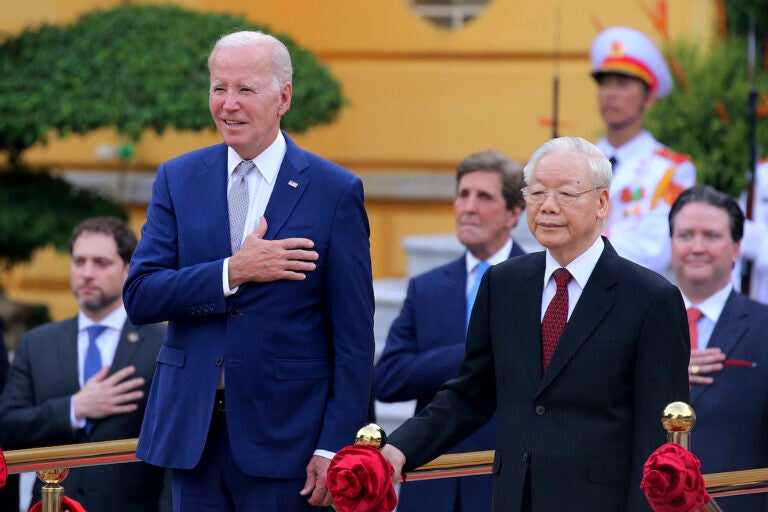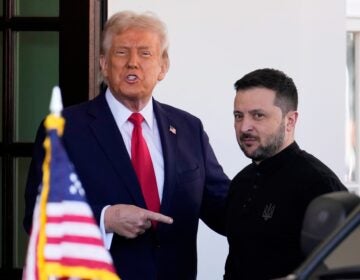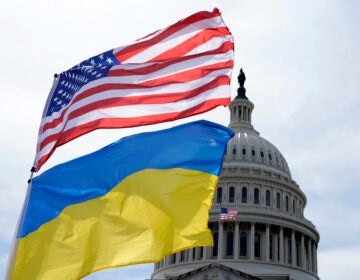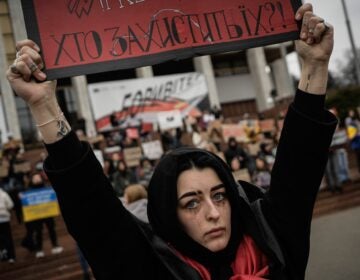Biden says stronger U.S. ties with Vietnam is about providing global stability, not containing China
It's Biden's first time in Vietnam, and his stop comes as Vietnam has elevated the U.S. to its highest diplomatic status, comprehensive strategic partner.

Vietnamese General Secretary of the Communist Party Nguyen Phu Trong, front right, and US President Joe Biden (front left) attend a military welcome ceremony at the Presidential Palace in Hanoi, Vietnam, Sunday, Sept.10, 2023. Biden is on an official two-day visit in Vietnam. (Luong Thai Linh/Pool Photo via AP)
President Joe Biden insisted Sunday that he is not trying to start a “cold war” with China as he made his first visit to Vietnam, saying his goal is to provide stability around the world by building U.S. ties with Vietnam and other Asian countries.
“We have an opportunity to strengthen alliances around the world to maintain stability. That’s what this trip is all about,” Biden said at a news conference after arriving in Vietnam’s capital from the Group of 20 summit in India. “It’s not about containing China. It’s about having a stable base.”
The American president came to Hanoi as Vietnam was elevating the United States to its highest diplomatic status, comprehensive strategic partner. That is evidence of how far the relationship has evolved from what Biden referred to as the “bitter past” of the Vietnam War.
The expanded partnership reflects a broader effort across Asia to counter China’s influence. Biden has said Vietnam wants to flex a degree of independence, and U.S. companies are seeking an alternative to imports from Chinese factories. He is pursuing these agreements while also trying to soothe any tensions with China.
Biden opened his news conference by saying he had “traveled around the world in five days,” from Washington to New Delhi and now Hanoi, showcasing efforts by his administration to forge alliances. The packed schedule and jet lag appeared to have taken a toll on the 80-year-old president, who tried to end his appearance before the media by saying “I’m going to go to bed.”
In response to one question, Biden told reporters he had met with Chinese Premier Li Qiang during the G20. The contact is the highest level interaction between U.S. and Chinese officials since Biden and China’s president, Xi Jinping, held talks at last year’s G20 in Indonesia. Xi skipped the India talks and sent Li in his place.
“We talked about stability. … It wasn’t confrontational at all,” Biden said.
The exchange, between G20 sessions Saturday, was brief, according to a senior Biden administration official. It was not clear who approached whom, but Biden was interested in seeing Li and underscoring his desire to stabilize the up-and-down relationship between the two countries, said the official, was not authorized to discuss the matter publicly and spoke on condition of anonymity.
Biden went into meetings with Vietnam’s leaders after his arrival. He welcomed the new partnership and said he hoped for progress on the climate, economy and other issues during his 24-hour stop in Hanoi.
“We can trace a 50-year arc of progress between our nations from conflict to normalization to this new elevated status,” Biden said with Nguyễn Phú Trong, general secretary of the Communist Party of Vietnam, at party headquarters.
Biden, who has described himself as being part of the “Vietnam generation” although he did not serve in a war, called Vietnam “a friend, a reliable partner and a responsible member of the international community.” He noted that veterans such as John Kerry, Biden’s climate czar, and John McCain, the late former Republican senator from Arizona, found ways to build a relationship with Vietnam after the war.
“Both men saw so clearly, as I and so many others did, how much we had to gain by working together to overcome a bitter past,” he said.
Trong pledged that his country will work hard to implement the agreement. “Only then can we say it is a success,“ he pledged.
During an earlier appearance with Trong, Biden had described the U.S. and Vietnam as “critical partners at what I would argue is a very critical time.” Neither leader specifically discussed how China’s economic and geopolitical rise had contributed to their countries’ newfound partnership, yet it was hard to explain the mutual embrace without Beijing’s regional influence.
Vietnam previously bestowed the same level of relations on China and Russia. Elevating the U.S. suggests that Vietnam wants to hedge its friendships as U.S. and European companies look for alternatives to Chinese factories.
With China’s economic slowdown and Xi’s consolidation of political power, Biden sees an opportunity to bring more nations, including Vietnam and Cambodia, into America’s orbit.
Biden was welcomed upon his arrival with a pomp-filled ceremony outside the mustard-colored Presidential Palace. Schoolchildren lined the steps and waved American and Vietnam flags. Biden watched from an elevated review stand as high-stepping members of the military marched past.
Biden and Trong Both expressed happiness over seeing each other again after last meeting some eight years ago in Washington, said Biden, who was vice president at that time.
Trong sought to flatter Biden, who is running for reelection next year and faces persistent questions at home about his age.
“You have nary aged a day, and I would say you look even better than before,” Trong said. “I would say every feature of you, Mr. President, is complementing your image.” Biden chuckled.
Biden was given five draft deferments and was exempted from military service because he had asthma as a teenager.
Meantime, Jon Finer, Biden’s chief deputy national security adviser, addressed reports that Vietnam was pursuing a deal to buy weapons from Russia, even Hanoi was seeking stronger relations with the U.S. Finer acknowledged Vietnam’s lengthy military relationship with Russia. He said the U.S. continues to work with Vietnam and other countries with similar ties to Russia, in an effort to try to limit their interactions with Moscow, which Washington accuses of committing war crimes and violating international law with its aggression in Ukraine.
U.S. trade with Vietnam has already accelerated since 2019. But there are limits to how much further it can grow without improvements to the country’s infrastructure, its workers’ skills and its governance. Nor has increased trade automatically put the Vietnamese economy on an upward trajectory.
U.S. Commerce Secretary Gina Raimondo said that the CEOs she talks with rank Vietnam highly as a place to diversify supply chains that, before the coronavirus pandemic, had been overly dependent on China. Raimondo has been trying to broaden those supply chains through the Indo-Pacific Economic Framework, an initiative Biden launched last year.
Vietnam’s economic growth slipped during the first three months of 2023. Its exporters faced higher costs and weaker demand as high inflation worldwide hurt the market for consumer goods.
Still, U.S. imports of Vietnamese goods have nearly doubled since 2019 to $127 billion annually, according to the U.S. Census Bureau. It is unlikely that Vietnam, with its population of 100 million, can match the scale of Chinese manufacturing. In 2022, China, with 1.4 billion people, exported four times as many goods to the U.S. as did Vietnam.
—-
Associated Press writer Darlene Superville in Washington contributed to this report.
WHYY is your source for fact-based, in-depth journalism and information. As a nonprofit organization, we rely on financial support from readers like you. Please give today.





